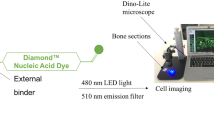Abstract
Identifying and tracking proliferating and quiescent cells in situ is an important phenotyping component of skeletal tissues in development, physiology and disease. Among all the methods that exist, which include immunostaining for cell cycle-specific proteins, the gold standards use thymidine analogs. These compounds label proliferating cells by being incorporated into de novo–synthesized genomic DNA. 5-bromo-2′-deoxyuridine (BrdU) has traditionally been used for this purpose, but its detection is lengthy and requires harsh treatment of tissue sections to give access of anti-BrdU antibody to DNA. An alternative, more recently developed, uses 5-ethynyl-2′-deoxyuridine (EdU). This thymidine analog is detected by click chemistry, that is, covalent cross-linking of its ethynyl group with a fluorescent azide that is small enough to easily penetrate native tissues and reach DNA. In addition to being simple and quick, this EdU-based assay is compatible with other protocols, such as immunostaining, on the same tissue sections. We here describe an EdU-based protocol optimized to label and functionally assess actively proliferating cells as well as slowly dividing cells, including stem cells, in mouse skeletal tissues.
Access this chapter
Tax calculation will be finalised at checkout
Purchases are for personal use only
Similar content being viewed by others
References
Kozhemyakina E, Lassar AB, Zelzer E (2015) A pathway to bone: signaling molecules and transcription factors involved in chondrocyte development and maturation. Development 142:817–831
Rumman M, Dhawan J, Kassem M (2015) Concise review: quiescence in adult stem cells: biological significance and relevance to tissue regeneration. Stem Cells 33:2903–2912
Yip RKH, Chan D, Cheah KSE (2019) Mechanistic insights into skeletal development gained from genetic disorders. Curr Top Dev Biol 133:343–385
Marie PJ (2015) Osteoblast dysfunctions in bone diseases: from cellular and molecular mechanisms to therapeutic strategies. Cell Mol Life Sci 72:1347–1361
Hughes WL, Bond VP, Brecher G, Cronkite EP, Painter RB, Quastler H, Sherman FG (1958) Cellular proliferation in the mouse as revealed by autoradiography with Tritiated thymidine. Proc Natl Acad Sci U S A 44:476–483
Gratzner HG (1982) Monoclonal antibody to 5-bromo- and 5-iododeoxyuridine: a new reagent for detection of DNA replication. Science 218:474–475
Mead TJ, Lefebvre V (2014) Proliferation assays (BrdU and EdU) on skeletal tissue sections. Methods Mol Biol 1130:233–243
Podgorny O, Peunova N, Park JH, Enikolopov G (2018) Triple S-phase labeling of dividing stem cells. Stem Cell Rep 10:615–626
Newton PT, Li L, Zhou B, Schweingruber C, Hovorakova M, Xie M, Sun X, Sandhow L, Artemov AV, Ivashkin E, Suter S, Dyachuk V, El Shahawy M, Gritli-Linde A, Bouderlique T, Petersen J, Mollbrink A, Lundeberg J, Enikolopov G, Qian H, Fried K, Kasper M, Hedlund E, Adameyko I, Sävendahl L, Chagin AS (2019) A radical switch in clonality reveals a stem cell niche in the epiphyseal growth plate. Nature 567:234–238
Salic A, Mitchison TJ (2008) A chemical method for fast and sensitive detection of DNA synthesis in vivo. Proc Natl Acad Sci U S A 105:2415–2420
Zeng C, Pan F, Jones LA, Lim MM, Griffin EA, Sheline YI, Mintun MA, Holtzman DM, Mach RH (2010) Evaluation of 5-ethynyl-2′-deoxyuridine staining as a sensitive and reliable method for studying cell proliferation in the adult nervous system. Brain Res 1319:21–32
Acknowledgments
This work was supported by NIH/NIAMS grants AR68308 and AR72649 to VL.
Author information
Authors and Affiliations
Corresponding author
Editor information
Editors and Affiliations
Rights and permissions
Copyright information
© 2021 Springer Science+Business Media, LLC, part of Springer Nature
About this protocol
Cite this protocol
Angelozzi, M., de Charleroy, C.R., Lefebvre, V. (2021). EdU-Based Assay of Cell Proliferation and Stem Cell Quiescence in Skeletal Tissue Sections. In: Hilton, M.J. (eds) Skeletal Development and Repair. Methods in Molecular Biology, vol 2230. Humana, New York, NY. https://doi.org/10.1007/978-1-0716-1028-2_21
Download citation
DOI: https://doi.org/10.1007/978-1-0716-1028-2_21
Published:
Publisher Name: Humana, New York, NY
Print ISBN: 978-1-0716-1027-5
Online ISBN: 978-1-0716-1028-2
eBook Packages: Springer Protocols




